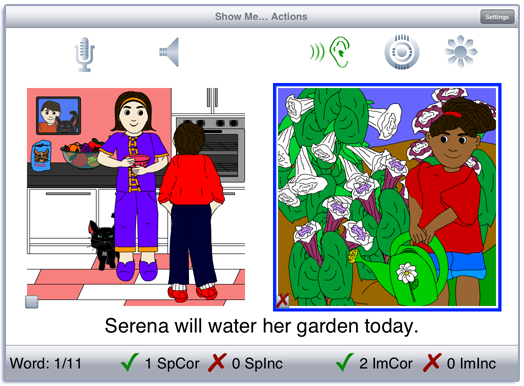
The pictures in this app are scenes from the lives of a set of characters. We see them eating, playing, sleeping, and studying around their house, school, and town. Each scene has a main idea that is usually fairly obvious and often it has several sub-themes that you can explore with the child.
The “Show Me” prompt will ask for the main idea. A typical prompt would be “Show Me… George drank a glass of juice.” or “Show Me… Serena fell and hurt her knee.” The prompt requires the child to identify the picture that best exemplifies the main idea of the sentence.
Target Audience This app is recommended for children with language ages from 6-12, while younger and older children may be able to benefit from the complexity of the sentences.
Just $1.99 on the App Store.
See More Images
View the Wordlist
Information for Professionals
This is an Intermediate Level app that requires moderate level inference skill. There are 121 pictures in nine categories: Cleaning, Playing, Learning, Celebrating, Making, Eating, Family, Courtesy, and Miscellaneous. It teaches receptive and expressive language skills while children practice their good speech.
Clinician guidance is suggested for the first several sessions in order to make the most of the question/answer format. Individuals with language disorders, central auditory processing dysfunction, short term auditory memory dysfunction and those with autism may benefit from learning multiple ways to ask and answer questions.
This app is also appropriate for hearing impaired individuals involved in an auditory habilitation or auditory rehabilitation program. The pictures may also be used to stimulate conversational speech, check auditory comprehension, and for novel sentence generation when presented with a picture.
This app is based on the Word Practice game from LocuTour’s Artic Games & More! CD.
Rationale Responding to a direct request such as “Show Me…” is an important response. It indicates the receptive understanding of the command and the target word, and it shows the ability to demonstrate comprehension using an expressive motoric response. Expressive language can be encouraged by having the child name the target, use the word in a phrase, sentence, or short conversation.